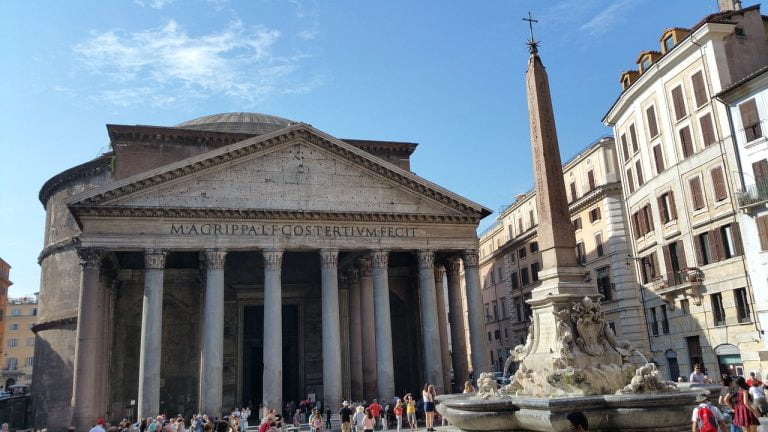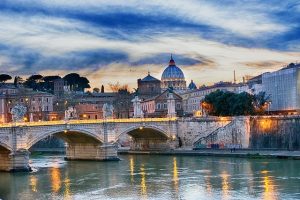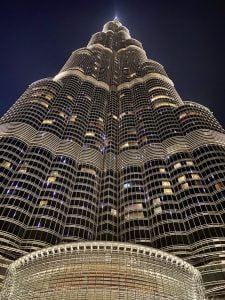Standing tall as an architectural wonder and testament to Rome's rich history, the Pantheon continues to amaze millions of visitors every year.
While it is no stranger to the itineraries of countless tourists, there is so much more to this ancient temple than meets the eye. Take a journey with us as we delve into the Pantheon's unrivaled architecture, the mythical and historical relevance of this landmark, and the painstaking efforts taken to preserve its ancient treasures. From navigating the ins and outs of the Rotunda to planning your visit with practical information, this guide has you covered. So without further ado, let's explore the treasures of the Pantheon, the soul of Rome that has stood the test of time.
Introduction to the Pantheon in Rome
An architectural masterpiece located in the heart of Rome, the Pantheon continues to fascinate historians, architects and casual visitors alike for its stunning beauty and timeless relevance. Often hailed as the epitome of ancient Roman engineering, this magnificent structure has withstood the ravages of time while maintaining the delicate balance of grandiosity and harmony. The Pantheon, originally built as a temple dedicated to the gods, over the centuries serves as evidence of the historical and cultural transformations of Rome itself.
Built around 126 AD under the reign of Emperor Hadrian, the Pantheon replaced an earlier temple commissioned by Marcus Agrippa, built sometime between 27 and 25 BC. Entering the Pantheon today, visitors can marvel at the grandeur of the structure, which seems untouched by time . As a result, the Pantheon's historical importance goes beyond its role as a former temple and place of worship. It is not only a monument to Rome's ancient culture and religion, but also an enduring symbol of its empire's engineering prowess, resourcefulness, and ambitious spirit. Through this lens, this tour guide aims to explore the architectural wonders, rich history and cultural significance of the Pantheon in Rome.
The architectural wonder of the Pantheon
The Pantheon is an extraordinary architectural wonder that has stood the test of time and continues to fascinate visitors to Rome with its unique design and construction. The structure is a perfect combination of symmetry, proportion and harmony, qualities that were of utmost importance in ancient Roman architecture. The temple dates back to 27 BC, and its fascinating design has inspired countless modern buildings, such as the United States Capitol and the British Museum.
One of the main features that distinguish the Pantheon from other ancient buildings is its huge central dome. This impressive dome, with a diameter of 43.3 meters, was once the largest in the world and remains the largest concrete dome to this day. The construction of the dome is an engineering masterpiece, using a highly innovative concrete mix that becomes lighter and thinner upwards, with the dome design on the inner surface further reducing the weight of the dome and adding visual depth to the space.
The perfect proportions
The design of the Pantheon maintains a clear sense of proportion and harmony. The height of the rotunda and the diameter of the dome are equal, both measuring 43.3 meters, which creates a sense of balance and unity within the building. This ratio between height and diameter represents a perfect sphere wrapped inside a cylinder, reflecting the ancient belief in the geometric perfection of the cosmos.
portico and oculus
The front of the Pantheon includes a magnificent portico supported by Corinthian columns, topped by a triangular pediment. This entrance serves as a striking contrast to the massive dome behind it and shows the grandiosity of the building's appearance. Another unusual feature of the Pantheon's architectural design is the oculus, a 9-meter-wide circular opening at the top of the dome. This opening serves not only as a source of natural light but also as a symbolic representation of the connection between the earthly and divine realms.
In conclusion, the architectural wonder of the Pantheon captures the ingenuity of ancient Roman architects and engineers and serves as a testament to their unparalleled skill and vision. The temple's awe-inspiring design, including its vast dome, perfectly proportioned rotunda, grand portico and iconic oculus, has continued to inspire and fascinate visitors to Rome for thousands of years.
Rotunda of the Pantheon
The Rotunda, or central circular room of the Pantheon, is undoubtedly the highlight of this architectural wonder. Its sheer size and richly decorated interior have captivated the attention of visitors for centuries. The rotunda dome is one of the most significant achievements in the history of architecture, and its well-preserved condition serves as a testament to the genius planning and engineering abilities of the ancient Romans. In the following paragraphs we will delve into the intricacies of the rotunda and its unusual dome to better understand their meaning.
The perfect proportions of the dome and rotunda
A visit to the Pantheon reveals a unique harmony in the building's proportions. The height of the face of the rotunda is equal to its diameter, making it a perfect hemisphere. Its dimensions are 43.3 meters in both dimensions, this equality creates an immediate sense of balance and symmetry within the enclosed space. The Roman architects and engineers skillfully designed the overall design, combining immense creativity in combining architectural styles and materials to achieve this optimal form.
The construction of the dome
One of the main reasons for the Rotunda's enduring fame is its magnificent dome. Although built nearly two thousand years ago, it remains one of the largest unsupported domes in the world. The engineering prowess of the Roman builders is evident in the construction of the dome, which is characterized by thickness and weight decreasing upwards. The use of an innovative concrete mix, combined with carefully placed releasing arches and a central oculus to reduce weight, allows the dome to maintain its structural integrity.
The dome's complex coffered ceiling adds both aesthetics and a structural advantage. The decorative rectangular niches break the monotony of the vast surface while serving a functional purpose of reducing weight. The dome not only relieves the burden of the dome, but also adds a magical play of light and shadow on the surface of the face.
The oculus and the symbolism of light
At the top of the Pantheon's dome, the oculus or "the eye", is a monumental skylight with a diameter of 8.7 meters. The oculus has no glass or any other covering and serves as the only source of natural light inside the rotunda. The sunlight streaming through the oculus illuminates the interior in amazing patterns, creating a heavenly atmosphere that changes throughout the day. The moving light in the Pantheon can be seen as a symbol of the sun's divine journey, reflecting the spiritual and heavenly meaning of the temple itself.
In conclusion, the rotunda of the Pantheon is an awe-inspiring masterpiece that showcases the amazing architectural and engineering abilities of the ancient Romans. Its perfect proportions, ingenious construction and the interplay of light through the oculus make it a must see for all lovers of art, history and architecture.
Preservation efforts of ancient finds in the Pantheon
The Pantheon is not only an architectural marvel but also a treasure trove of ancient objects that have stood the test of time. The conservation and preservation of these precious works is of utmost importance to ensure that future generations can also appreciate and learn from them. In this part we will delve into the conservation efforts of the authorities, the challenges they face and the role of modern technology in preserving these findings.
Conservation challenges
Over the centuries, the Pantheon's ancient artifacts have faced various challenges, from theft and vandalism to natural disasters and wear and tear from exposure to the elements. The building itself has undergone many renovations and renovations to preserve its original glory. Similarly, the artifacts housed in the Pantheon require constant care and attention to prevent further deterioration.
Techniques and means of preservation
Various conservation techniques are used to protect and preserve the finds within the Pantheon. These include regular cleaning, monitoring for signs of damage, and controlling factors such as humidity, temperature and natural light. Precautions are also taken to minimize human interaction with the objects, including the use of barriers, display cases and signage. The items are also periodically inspected and documented, allowing conservators to make informed decisions about their maintenance and restoration.
One of the most prominent examples of conservation actions in the Pantheon is the restoration of the ancient marble floor. Over time, erosion from foot traffic led to a loss of the intricacy of the patterns, prompting authorities to undertake a careful restoration process. This involved cleaning, consolidating and recombining missing pieces of marble to maintain the original beauty and integrity of the floor.
The role of modern technology
Modern technology has revolutionized conservation, and the Pantheon is no exception. Advanced imaging techniques such as infrared and ultraviolet photography are used to study and monitor the condition of objects, allowing conservators to detect any signs of deterioration or damage at an early stage. Laser technology was also used to remove dirt and corrosion while preserving the surface of the object.
XNUMXD scanning and printing technologies are increasingly being used in conservation efforts. These technologies enable the creation of exact and detailed replicas of the objects, which can be displayed while the original is kept safely in controlled environments. Furthermore, digital technology also helps document and share data related to objects, fostering collaboration between experts around the world.
In conclusion, the conservation and preservation of ancient artifacts in the Pantheon is a crucial and ongoing process. Combining traditional conservation techniques with modern technologies ensures that these treasures will continue to fascinate and educate future generations about Rome's rich history and culture. As you explore the Pantheon in more detail in the following sections, remember that these relics of the past are a testament to the dedicated efforts of conservators who work tirelessly to protect and preserve them.
The mythical and historical relevance of the pantheon
The Pantheon has a special place in the rich history and mythology of Rome. As a temple dedicated to the worship of the Roman gods, the Pantheon represents an important element of the city's cultural and religious heritage. In this part we will explore the central aspects of the mythology and history of Rome intertwined in the Pantheon and examine the continued importance of the temple in the development of the city.
The Pantheon as a temple to the gods
The origins of the Pantheon lie in the time of ancient Rome, when the temple was dedicated to the worship of all the Roman gods. The word "pantheon" comes from the Greek words "pan" (all) and "theon" (divine), which means "all the gods". It is believed that the temple was originally built to honor the gods Mars and Venus, as well as the divine lineage of the emperor Augustus, whose family claimed descent from the gods.
This connection between the pantheon and the gods played a crucial role in the religious landscape of Rome. The temple served as a prominent place of worship and as a temple to the gods, showcasing the city's commitment to God and providing a unifying space for its citizens to come together in devotion.
The conversion of the Pantheon and its evolving historical significance
Over the centuries the role of the Pantheon underwent considerable changes and adaptations. In 609 AD, after the fall of the Roman Empire, the Pantheon was given to the Christian Church by Emperor Phocas and dedicated as the Church of Santa Maria ad Martyrs. This conversion allowed the building to continue to serve a religious purpose and helped preserve the building from destruction, as many other ancient Roman buildings suffered during the Middle Ages.
This adaptation gave the Pantheon additional historical importance, as it became a meeting point between the ancient Roman religion and Christianity, illustrating the cultural change that took place. Today, the Pantheon also serves as the tomb of prominent Italian figures, including kings and influential artists such as the Renaissance painter Raphael, further cementing its importance within Italy's historical narrative.
The Pantheon's role in art and architecture
Beyond its religious and historical importance, the Pantheon also influenced the world of art and architecture. Its unique design, which includes a large dome on the facade of a traditional Roman temple, has inspired countless architects throughout the ages. The architectural innovations of the Pantheon, such as the central oculus of the dome and the use of concrete, became important elements in the development of Western architecture.
Furthermore, the Pantheon played a key role in the world of art and literature. Artists and writers have been drawn to the temple's stunning architecture and its connection to Rome's ancient history, making it a common setting for works and perpetuating the building's mythic and historical relevance in popular culture.
In conclusion, the mythical and historical relevance of the Pantheon is multifaceted, as it embodies the religious, cultural and artistic heritage of the city. As a temple dedicated to the worship of Rome's ancient gods, a meeting point between two significant religious traditions and a monument of architectural achievement, the Pantheon's lasting influence is unquestioned and continues to be a vital symbol of Rome's rich past.
Visiting the Pantheon: entrance fees and additional practical information
A visit to the Pantheon in Rome is an unforgettable experience for anyone who wants to witness architectural mastery combined with ancient history. This section offers practical information for tourists visiting the Pantheon, ensuring a smooth and enjoyable journey and fully appreciating the beauty and significance of this iconic monument.
One of the most attractive aspects of the Pantheon is that there is no entrance fee. Yes, you read that right! Access to the Pantheon is free, making it an affordable and accessible attraction for all visitors. However, it is important to note that while admission is free, you should consider making a small donation to support the preservation and maintenance of this historic site. Donation boxes are usually located near the entrance or inside the temple.
Being a popular attraction, it is essential to know the visiting hours to avoid disappointment. The Pantheon is open Monday through Saturday from 9:00 a.m. to 19:30 p.m., and on Sundays from 9:00 a.m. to 18:00 p.m. Furthermore, during public holidays, its timings may vary. It is best to visit the Pantheon early in the day or later in the afternoon to avoid large crowds and long queues.
While the casual nature of visiting the Pantheon may give the impression of a relaxed dress code, remember that the Pantheon is a religious monument. Therefore, it is recommended to dress modestly, covering your shoulders and knees, as you would when visiting any holy site. Also, hats must be removed upon entering the building as a sign of respect.
Restrictions and considerations for visitors
As the Pantheon is a historical treasure of immense religious and cultural significance, it is essential to follow certain guidelines during your visit. For example, it is forbidden to eat, drink or smoke inside the Pantheon. In addition, visitors are expected to maintain appropriate noise levels, and silence is appreciated throughout the monument, especially during mass.
Photography is generally allowed inside the Pantheon, but the use of tripods and flash is not recommended to avoid disturbing other visitors and to protect the artworks inside. It is essential to respect these rules, as they help maintain a peaceful and respectful atmosphere for all to appreciate the history and grandeur of the monument.
Special events and ceremonies
The Pantheon still operates as a Catholic church and occasionally hosts masses and prayers. During these times or special events, such as religious holidays, the Pantheon may have limited access to the general public, or certain areas may be closed. It is recommended to check the Pantheon's official website for event schedules and updates before planning a visit to ensure uninterrupted access to the monument.
How to get to the Pantheon in Rome?
Getting to the Pantheon in Rome can be an exciting adventure in itself, as the city offers many transportation options for visitors. Whether you prefer public transportation, walking or taking a taxi, it is important to know the different routes and options to make the trip as smooth as possible. Here we will explore the different ways to get to the Pantheon and provide useful tips for your visit.
Public Transport
One of the friendliest and most efficient ways to get to the Pantheon is via Rome's public transportation system. The city is well connected through its network of buses, trams and metro lines. To get to the Pantheon, you can take the metro to the Barberini station (line A) or to the Colosseo station (line B) and then walk for about 15 minutes. Alternatively, you can take one of several buses that stop nearby, such as bus number 40, 64 or 30. Be sure to purchase a bus or metro ticket before boarding the plane. Tickets can be found at metro stations, tobacco shops, newsstands, and cost around NIS 1.50.
Taxi services and shared rides
If you prefer a more direct and convenient means of transportation, you can take a taxi or use ride-sharing services like Uber or Lyft. Keep in mind that taxis in Rome can be quite expensive, especially during rush hour, and the narrow streets around the Pantheon may make it difficult for the driver to drop you off right in front of the monument. Therefore, it is recommended to ask the driver to drop you off at the nearest possible point and walk the remaining distance.
hiking trails
Rome is a walkable city with many charming streets and delightful views, making a leisurely trip to the Pantheon an enjoyable experience. If you are staying in the historic center, the hotel is within easy walking distance of several popular landmarks, such as the Trevi Fountain or Piazza Navona. Walking to the Pantheon will not only allow you to soak up the magical atmosphere of Rome, but will also help you save on transportation costs.
With these different options at your disposal, getting to the Pantheon in Rome should be easy. Remember to consider factors such as budget, time constraints, and personal preferences when choosing your mode of transportation. Once you reach the Pantheon, you can continue to explore its architectural wonders, as discussed in the previous sections of this guide.
Sites and attractions around the Pantheon Rome
The area surrounding the Pantheon in Rome is full of various other attractions that tourists should make sure to visit. Exploring these destinations will surely add an unforgettable cultural experience to your trip.
One of the most significant attractions is Piazza della Rotonda, a lively square just outside the Pantheon. This lively space is filled with artists, buskers and local vendors offering various Italian delicacies. This is a wonderful place to take photos, sit down for a coffee, or enjoy an authentic Italian meal in one of the surrounding restaurants and cafes.
Another must-see destination is the Church of Sant'Ivo alla Sapienza, an architectural masterpiece designed by the famous Baroque architect Francesco Borromini. This unique and fascinating church features a corkscrew-shaped dome that resembles a spiral staircase.
For art lovers, the National Museum of Palazzo Venezia, located near the Pantheon, is an ideal stop. The museum is known for hosting an extensive collection of artworks and historical artifacts from the Middle Ages and the Renaissance, providing insights into Italy's rich history and cultural heritage.
Other nearby attractions include the Largo di Torre Argentina, an important archaeological site that hides the ruins of four ancient Roman temples, and the Trevi Fountain, Rome's iconic and ornate Baroque masterpiece. Exploring these sights and attractions around the Pantheon will undoubtedly enhance your visit to this spectacular Roman wonder.
Restaurants and cafes near the Pantheon
Below is a list of four recommended restaurants and cafes near the Pantheon, offering a variety of cuisines and delicious food items for visitors to enjoy.
| Name | The type of kitchen | Distance from the Pantheon | Average price (in new shekels) |
|---|---|---|---|
| Armando El Pantheon | Traditional Italian | 50 meter | 100 - 150 NIS |
| Casa Bléve | ים תיכוני | 250 meter | 80 - 130 NIS |
| Antico Caffè Sant'Eustachio | Cafe and pastry shop | 200 meter | 30 - 60 NIS |
| Sliding pizza | Pizza and Italian street food | 300 meter | 40 - 80 NIS |
Frequently asked questions about The Pantheon in Rome
Below are some frequently asked questions about the Pantheon in Rome to help enrich your understanding of this iconic historical site.
- When was the Pantheon originally built?
The Pantheon was first built during the reign of Augustus (around 27 BC – 14 AD) under the guidance of Marcus Agrippa, making it over 2,000 years old. However, the current structure is believed to have been rebuilt during the reign of Emperor Hadrian in 126 AD. - What type of building materials were used in the Pantheon?
The Pantheon was built mainly of Roman concrete and brick concrete, which contributed to its durability over time. The interior of the dome is decorated with intricate patterns and a decorated ceiling, built of cast santina and covered with plaster. - Why did the dome of the Pantheon remain intact for so many centuries?
The dome of the Pantheon remained intact due to its unique design and the use of lightweight concrete in its construction, which reduces the pressure on the supporting walls. The oculus, a central opening in the dome, also helps distribute the weight evenly. - What was the main purpose of the Pantheon in ancient Rome?
The Pantheon was initially built as a temple dedicated to the worship of all the Roman gods. Over time, its purpose developed, and it was used as a church, a tomb and a treasury for relics and various important findings. - Can you attend Mass at the Pantheon?
Yes, since the Pantheon has been used as a church since the 7th century, visitors can attend Catholic services on specific days, such as Sundays and religious holidays. It is essential to respect the dress code and maintain respectful behavior during your visit. - Is it allowed to take pictures inside the Pantheon?
Yes, it is allowed to take pictures inside the Pantheon. However, the use of flash is not recommended to protect the integrity of the artwork and maintain the festive atmosphere of the site. It is also recommended to respect any specific restrictions that may apply to certain areas or objects.
The benefits of visiting the Pantheon in Rome
Discover the many benefits of visiting the Pantheon and learn about its architectural, historical and cultural importance.
- Architectural insight: Discover the unique and amazing design of the Pantheon, which has influenced architecture around the world for centuries.
- historical context: Immerse yourself in the rich history of Rome, as the Pantheon played a prominent role in its religious, cultural and political development.
- Conservation awareness: Understand the importance of preserving ancient artifacts and the techniques used by professionals to preserve the Pantheon's precious treasures.
- Mythological research: Delve into the fascinating connection between the Pantheon and the mythology of Rome, and enrich your knowledge of ancient Roman traditions.
- Practical information: Purchase essential details to make your visit to the Pantheon smooth, such as entrance fees, visiting hours and more.
- Easy accessibility: Find the best ways to reach the Pantheon by various means of transport, making it a convenient destination for travelers.
- Attractions nearby: Discover a wide variety of sites and attractions throughout the Pantheon, and maximize your experience in Rome. very far fromThe Vatican.



















